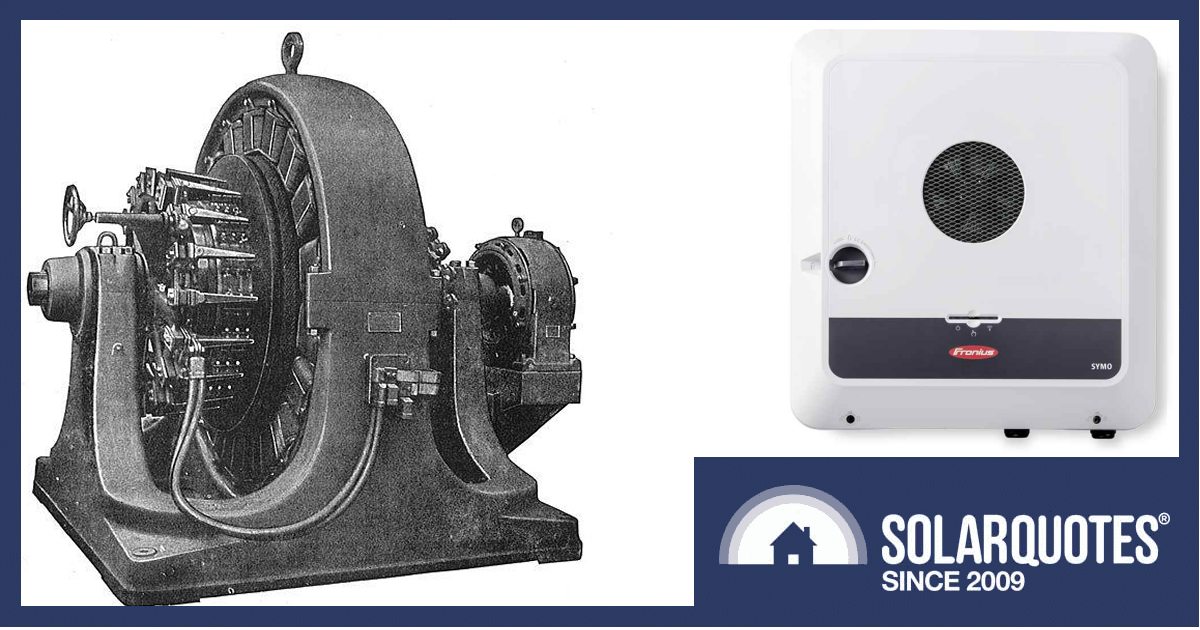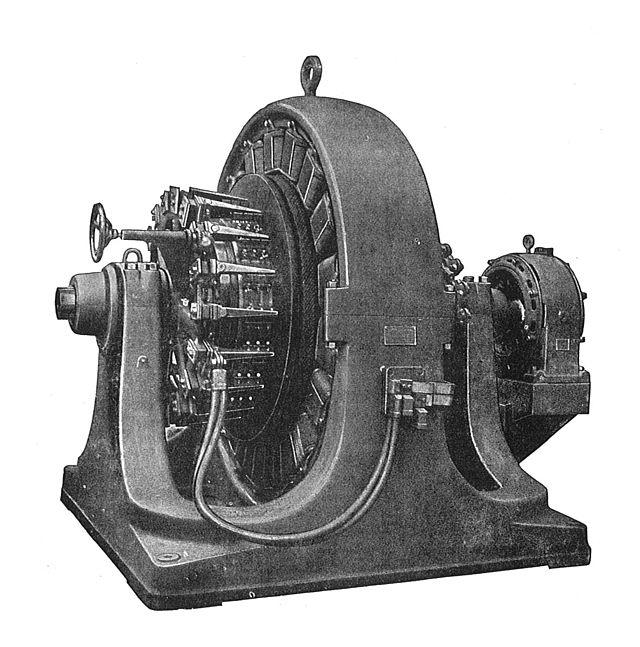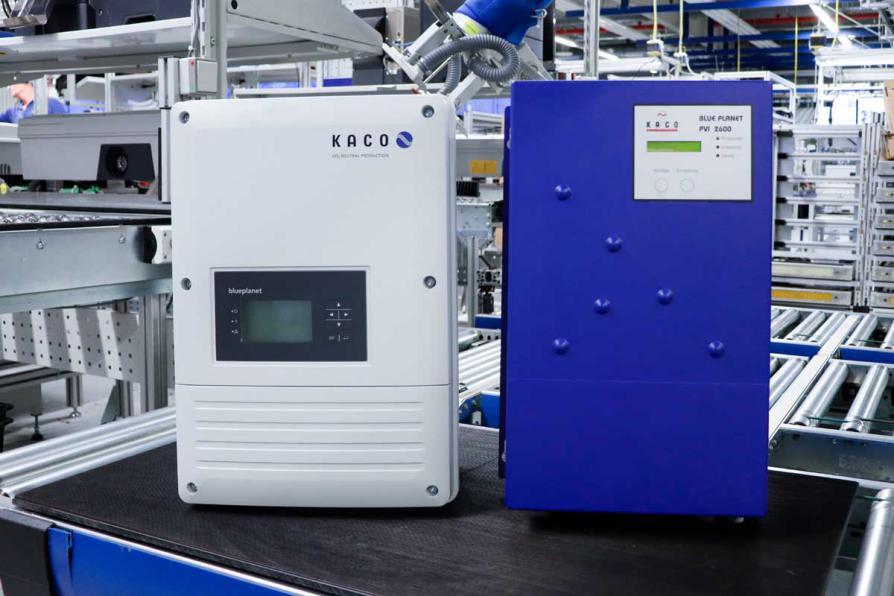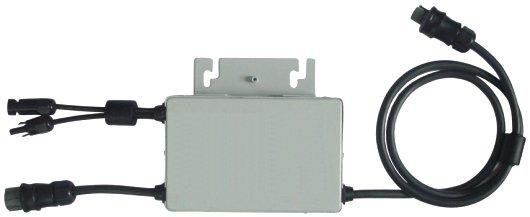
Over the past 100 years, many electrical and electronic devices have changed our lives and raised our living standards. One of these is the solar inverter – and in particular the grid-tied solar inverter.
In this article, I’ll tell you about the history of this device and how it has changed over time. Along the way, we’ll even find out why it is called an ‘inverter’.
Inverters Are PCE: Power Conversion Equipment
The modern solar inverter, in its simplest form, is a power converter. It converts DC power produced by solar panels into AC power for the appliances we use in our homes. But the first power converters did the opposite: they took AC power and converted it to DC.

500kW Westinghouse rotary converter
Charles S. Bradley invented the rotary converter in 1888. At the time most appliances and machinery operated on DC power, but AC transmission was quickly becoming dominant. There was a pressing need to convert the transmitted AC power into DC that the appliances could use.
Rotary converters and also motor-generator sets did this job from the late nineteenth century until the mid-twentieth century. Now when we talk about power converters like this – that convert AC to DC – we usually just call them ‘rectifiers’.
Where Does The Name ‘Inverter’ Come From?
The first known use of the term “inverter” was in 1925 by engineer David Prince. He published an article in the GE Review in which he wrote:
“the author took the rectifier circuit and inverted it, turning in direct current at one end and drawing out alternating current at the other”
So, a solar inverter is called an inverter because it reverses, or ‘inverts’ a rectifier’s operation.
From Mechanical To Electronic
By the 1950s inverters moved from being mechanical devices to ones with solid-state circuits. This was made possible by the dawn of a new field of engineering called ‘power electronics’.
Regular electronics were dominated by the humble transistor, which had insufficient voltage and current ratings for most inverter applications. Power electronics used a type of high-power transistor called a thyristor or SCR (silicon-controlled rectifier).
In 1953 German company Kaco manufactured the world’s first thyristor inverter. Years later Kaco would go on to produce the first transformerless inverter.
Transformerless Inverters
In 1999 a handful of “idealists” clambered onto the rooftops of homes in Baden-Württemberg to install solar PV systems. Accompanying them was the world’s first transformerless string solar inverter, the Kaco Blue Planet PVI 2600.

Solar inverter evolution: Today’s blueplanet 10.0 TL3 (left) has four times more power than the PVI 2600 20 years ago, but is the same size. Image: Kaco
The introduction of transformerless inverters in 1999 brought with it many advantages – being more efficient, lighter and cheaper to manufacture. The main drawback however was the lack of galvanic isolation between the DC and AC circuits, which could potentially allow the passage of dangerous DC faults to the AC side.
Galvanic isolation (provided by a transformer) separates the input and output supplies to a device so that energy flows through a field rather than via electrical connections. It enables power transfer between two circuits without being electrically connected.
Transformerless solar inverters created more than a few headaches for electricity network providers and resulted in another rewrite for industry standards associations around the world.
Microinverters
In June 2008 Californian company Enphase introduced their first microinverter1. It was about the size of a paperback book and was going to flip the solar industry on its head. So far that hasn’t happened.
The concept is a great idea because it sits underneath each solar panel and allows each panel in an array to operate independently of one another. In the event of one or multiple panels reducing output due to shading or failure, the rest of the array will keep chugging along nicely. This is not the case with a single series string of solar panels feeding a string inverter.

The first Enphase Microinverter
Other advantages are numerous. They include panel level optimisation and monitoring, safer due to lower DC voltage and no DC cabling in roof space, panels can be oriented in different directions, simpler to design, panel model agnostic, easier PV array expansion and much longer inverter warranties.
The reason this technology hasn’t taken over the world is cost. They are expensive, complex to install and may have higher maintenance costs due to the amount of hardware on the roof.
So, microinverters vs string inverters, which is best? There’s no definitive answer.
New Kid On The Block – Hybrid Inverters
Hybrid inverters have been around for a while but are starting to gain some serious attention due to the increasing uptake of home battery systems.
These inverters are sophisticated, intelligent beasts that can simultaneously manage inputs from solar panels, a battery bank and utility grid using a technique called DC coupling (along with more than a few other bells and whistles).
The hybrid inverter’s brain can decide where to draw energy from, when and how to do it. It can make decisions based on the price of electricity at any given time, and even draw energy from the grid to store in the battery if that’s economical.
We’re likely to see more of these inverters from now on due to the growing realisation around the world of the importance of embracing technologies that will deliver net zero carbon emissions. Right now that means three things – batteries, batteries and more batteries.
Maximum Power Point Trackers (MPPT)
Arguably the holy grail of the modern PV solar inverter is the maximum power point tracker. Since 1954 when Bell Labs demonstrated the first practical silicon solar cell, researchers have been searching for the greatest efficiency available, aiming to continually improve the performance of a solar power system.
Maximum power point tracking finds the perfect sweet spot of voltage and current to maximize energy extraction from a string of solar panels in real time as conditions vary. This is particularity important in PV systems because output power from solar cells depends on the amount of available sunlight, shading, solar panel temperature and the load’s electrical characteristics.
All this good stuff happens inside the solar inverter so we don’t have to worry about it. But if you do want to worry about it – Finn explains how MPPT works here.
MPPTs are still being developed and improved in an ongoing quest to make solar inverters as efficient as possible.
Mass Production Of PV Solar Inverters
In 1991 German company SMA made their first solar product – the PV-WR 1800 inverter. It was a niche product and didn’t exactly fly off the shelves. A few years later in 1995 the Sunny Boy 700 was produced with this sales pitch from SMA:
“The technology, which is applied for the first time in the Sunny Boy 700, makes it much easier to install PV systems, enabling even electrical installers to assemble the systems safely.”
As an ex-solar-installer, I’ll try not to take offence. Maybe such insults from SMA are the real reason Fronius solar inverters are so popular with installers.
Just kidding SMA – we love you too. Especially since you got rid of Zeversolar.
Related: How To Choose A Good Solar Inverter | The Best Solar Inverters In 2022
Footnotes
- Although Enphase created the first commercially successful microinverter, they did not invent the microinverter concept ↩

 RSS - Posts
RSS - Posts



Microinverters were not first made by Enphase in 2008.
OKE made them since 1995 https://en.wikipedia.org/wiki/Solar_micro-inverter
I was part of a team at Pacific Solar installing PV systems with them in Sydney since 1998
Good point Jeremy, I’ve updated the post.
Dear friend,
This is Pandian.G , having 46years experience of Solar, power generation etc. Excellent explanations and awareness about Grid tie, micro, and hybrid Inverters, MPPT CC , it’s very useful to new comers of solar integrates, Developer’s, traders and students, My suggestions is that I may be right or wrong, that if you add one more topic of Solar DC Systems which can be used in small applications like small houses, street shopes, bus shelters, forest areas, tribal areas, small passenger boats or fery or fishing boats etc, no doubt it is there already but it is not much popular that’s what I mean and we can save the conversion losses since we use DC to AC Inverters for smaller applications. Thank you.
Regards
Pandian.G
Senior Solar Consultant.
Chennai.India
Mob / Whatsapp: 91-9940479188
“Microinverters
In June 2008 Californian company Enphase introduced their first microinverter1. It was about the size of a paperback book and was going to flip the solar industry on its head. So far that hasn’t happened.”
…and this article was written in 2022 huh? A quick google shows enphase absolutely dominates the microinverter market, and more than 50% share of the inverter market regardless of micro or string. They have the only on and off grid microinverters. If you get solar in 2022 it’s either soalredge or enphase… Friends don’t let friends write uninformed articles….
Microinverters are an important but still small portion of the residential solar market, although they have done particularly well in North America. Don’t fall for the Enphase trick of comparing the number of microinverter installations to the number of string inverter installations. There’s a reason why they’re called “micro”. Instead, compare the amount of solar panel capacity connected to them.